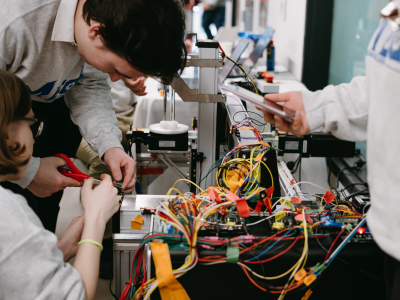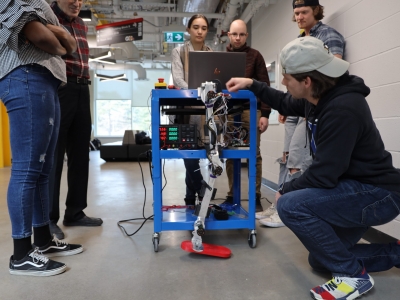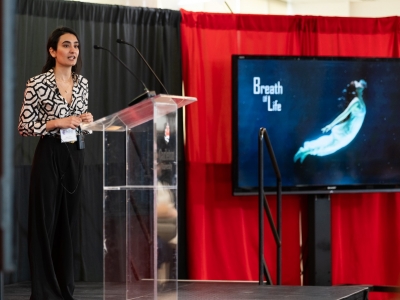
A team of fourth-year students from Carleton’s research-intensive Faculty of Engineering and Design have been awarded first prize in the 2016 Canadian Society for Civil Engineering (CSCE) National Capstone Design Competition.
This year’s competition, hosted on June 3 at the CSCE annual conference in London, Ontario, invited universities from across Canada to submit one fourth-year Capstone design project for consideration. Carleton’s nomination involved a multidisciplinary team that included 23 undergraduate students from the Department of Civil and Environmental Engineering, the Department of Mechanical and Aerospace Engineering, and the Department of Electronics.
Fourth-year Architectural Conservation and Sustainability Engineering students Joel Becker and Hailey Quiquero were chosen to present the team’s project, titled “Zibi Innovation Centre Integrated Design: a One Planet Development.” The project involved the retrofit of two historic industrial buildings and the complete design of a new mixed-use Innovation Centre and central atrium as part of the Windmill Development Group’s Zibi development on Ottawa’s Albert Island.
While Carleton engineering students engage in hands-on design projects throughout their years of study, Capstone fourth-year design projects serve as the hallmark of an undergraduate engineering degree. Students are required to work in teams to produce an original design innovation – one that applies everything they have learned over the course of their studies.

The multidisciplinary team behind the winning project included 23 undergraduate students from the Department of Civil and Environmental Engineering, the Department of Mechanical and Aerospace Engineering, and the Department of Electronics.
Hailey and Joel’s contributions to the project included designing architectural and structural retrofits for one of the existing buildings, along with the structural design of the new atrium. The two were also tasked with project management duties.
“One of the major challenges for this project was designing structural upgrades to the existing building while respecting its heritage value and considering the design requirements for a One Planet Living community,” notes Joel.
One Planet Living is a global initiative developed by BioRegional and the World Wildlife Federation that emphasizes both sustainability in the built environment and social sustainability for a community. It is based on ten guiding principles of sustainability, largely focusing on ecological and carbon footprinting.
In a society which has become increasingly environmentally conscious, Hailey believes that sustainable construction technologies have a major role to play in saving our planet.
“The field of green building design is growing and the demand for engineers with a knowledge base in sustainability is high,” she says. “Consideration for the environment has become an integral component of building design as industries look to reduce wastefulness and optimize design efficiency wherever possible.”
Joel also believes that architectural conservation and sustainability engineers are presented with unique opportunities to serve the community and better our society.
“It’s important to be able to recognize the value of Canada’s built heritage in society and take measures to preserve it for future generations,” he says. “Graduates of the Architectural Conservation and Sustainability Engineering program are equipped with that unique skillset and respect for built heritage.”

Hailey Quiquero and Joel Becker presented their team’s project at the 2016 Canadian Society for Civil Engineering (CSCE) National Capstone Design Competition, hosted at the CSCE annual conference in London, Ontario<br />on June 3, 2016.
Carleton’s unique Architectural Conservation and Sustainability Engineering program is the first of its kind in Canada to combine civil and environmental engineering and architectural studies. Architectural conservation and sustainability engineers specialize in sustainable green building design, considering life-cycle costs, impacts of selected materials, and energy needs and consumption. They also bring their expertise to the burgeoning field of conservation, repairing and adapting structures with various levels of heritage designation.
“When I was in high school I considered pursuing architecture, but I didn’t want to give up my love of math and physics,” explains Hailey. “The Architectural Conservation and Sustainability Engineering program at Carleton stood out to me because it combined my passion for creativity and technology, allowing me to get a taste for both structural engineering and architectural design.”
“There is no other undergraduate program like it in Canada,” adds Joel. “The variety of engineering and architecture classes challenged me to be creative and innovative in solving problems, which helped me to develop a strong foundation in structural design and engineering.
Both Hailey and Joel recently crossed the stage as graduates during Carleton’s convocation ceremonies this June. Looking back, the pair agree that their experiences outside of the classroom were a pivotal component of their education.
“Experiential learning was one of the most important parts of my degree,” says Hailey, who was honoured at convocation with a Senate Medal from Carleton for outstanding academic achievement. “Being a part of the Carleton Great Northern Concrete Toboggan Race Team, for example, exposed me to every step of the engineering process – from conceptualization, to design iterations, to actually being a part of the construction and application of that design.”
“Being a part of a multidisciplinary Capstone fourth-year design project prepared me for how an integrated design process would function in industry,” affirms Joel. “My role as the historic structures team lead taught me valuable leadership, organizational and communication skills.”
As part of a separate fourth-year independent research project, supervised by Professor Liam O’Brien, Joel also designed, built and tested his own heliodon, an apparatus that can be used to evaluate daylight in scaled building models. Spanning a total of eight months, the project included extensive technical drawings based on complex 3D solar geometry.

Joel Becker’s heliodon independent research project, supervised by Professor Liam O’Brien.
“It was amazing to get hands-on experience actually building something that I personally designed and developed,” says Joel. “It helped to expand my technical skillset, but it also taught me how to manage my time in order to deliver a project on-schedule and on-budget.”
Having now completed his undergraduate degree at Carleton, Joel is looking to begin his career as a structural engineer in training in the heritage industry. Hailey will be returning to Carleton in the fall to pursue a Master of Applied Science in Structural Engineering. Following her MASc degree, she aspires to work as a structural engineer at a firm with high environmental sustainability values.
About the Canadian Society for Civil Engineering National Capstone Design Competition
The (CSCE) National Capstone Design Competition is open to all senior undergraduate students in an accredited Canadian civil engineering program. This year, civil engineering departments from across the country were invited to submit a nomination for a single entry into the competition in any specialty area of the field (Structural, Construction, Geotechnical, Geomechanics, Hydraulics and Water Resources, Transportation or Environmental Engineering) for projects completed during the 2015-2016 academic year.



